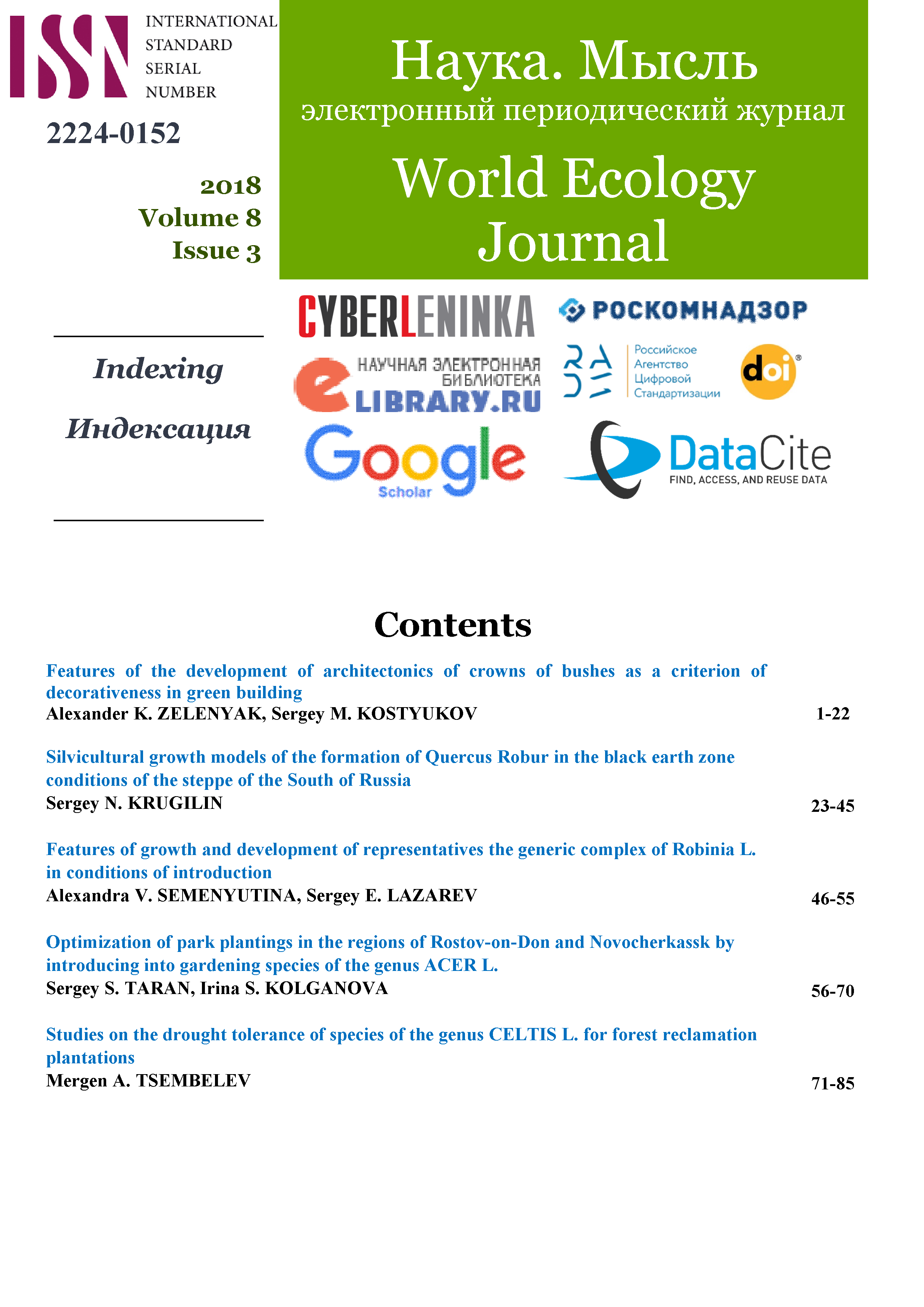Optimization of park plantings in the regions of Rostov-on-Don and Novocherkassk by introducing into gardening species of the genus ACER L.
DOI:
https://doi.org/10.25726/NM.2019.31.46.004Keywords:
Acer L., optimization, public facilities, landscaping, parkland, decorative durability, enrichment of the range, multifunctional role, types of planting, growth stimulantsAbstract
Maples are one of the best ornamental trees used in landscaping settlements in Russia and abroad.
An urgent task in the arid region is a bioecological rationale for optimizing the biodiversity of the Acer L. genus in public gardening (parks, squares, boulevards, street plantings) and clarifying the recommendations of production on the implementation of gardening works involving Acer L.
The article presents an assortment of woody species of the genus Acer L. recommended for optimizing planting of trees in Rostov-on-Don and Novocherkassk. The rating of the decorative qualities of maple trees has been established in comparison with other species used in gardening; as well as decorative durability of trees in urban environments. The highest scores on decorativeness are among maple and sycamore maple (202 and 201 points). Decorative durability of maples ranges from 45 to 80 years. The introduction of trees of the genus Acer L. into landscaping contributes to the enrichment of the range of recreational and landscaping plantings of the urban environment. An assortment of resistant ornamental woody plants of the genus Acer L. has been developed for public facilities in Rostov city agglomeration for various types of planting. It is recommended to plant in street plantings: Acer platanoides L .; A. platanoides 'Globosum', A. pseudoplatanus L., A. saccharinum L. As soliter use A. platanoides L. and its decorative forms, A. platanoides 'Globosum', A. pseudoplatanus L., A. negundo L. (golden and variegated forms). For hedges - A. ginnala L., A. tataricum L., A. campestre L.
Experiments with the use of growth stimulants showed that the best indicators of changes in linear dimensions and accumulation of phytomass were obtained using Krezacin 0.003% and SAN 0.01%. Acer L. achieved the best development on a fertilized background using SAN preparations of 0.01%, Humate 0.02% and 0.03%.
The issues of a comprehensive assessment of the status of tree species of the genus Acer L. and the basic agrotechnical technologies of growing planting material for gardening are substantiated. Developed measures to optimize the species composition of planting trees contribute to the improvement of the decorative functions of parkland.
References
2. Kostyukov S.M. Bioecological substantiation of the range of shrubs for landscaping urbolandscapes of the Lower Volga region: author. dis ... Cand. S.-H. Sciences All-Russian Research Institute of Agroforestry Volgograd, 2012. 24 p.
3. Kulygin A.A. Preparation of seeds of tree and shrub species for sowing: study guide for stud. specialist. "Lesn. and forestry farm "A.A. Kulygin; Novocherk. state melior Acad., Novocherkassk; 1999. 59 p.
4. Merinov Yu.N. The delimitation of the Rostov agglomeration Yu.N. Merinov, Yu.Yu. Merinova Naukovedenie. 2014. № 6.
5. Ivonin V.M. Forest Land Reclamation of Landscapes. Rostov n / d., 2001. 188 p.
6. Pokhilko L.O. Ecological principles of the formation of the range of woody plants in the landscaping of the city of Rostov-on-Don: author. dis. ... Cand. biol. sciences. Rostov n / D, 2009. 26 p.
7. Recommendations for the use of species of the genus Acer L. in landscape gardening of the Rostov agglomeration I.S. Kolganov; Ss Ram; Novocherk. Ing. a piece of chalk. Institute FSBEI HE Donskoy GAU. Novocherkassk, 2017. 24 p.
8. Romanov E.M. Forest cultures. Production and use of non-traditional organic fertilizers in forest nurseries: studies. allowance EM Romanov, T.V. Nureeva, D.I. Mukhortov. Yoshkar-Ola: Publishing house MarSTU, 2001. 156 p.
9. Semenyutina A.V. The effectiveness of the use of the cluster method in the analysis of the decorative advantages of greening plantings A.V. Semenyutina, I.Yu. Podkovyrov, S.S. Taran Global scientific potential. 2014. № 7 (40). Pp. 48-51.
10. Semenyutina A.V. Multifunctional role of adaptive recreational greening plantings in urbanized areas A.V. Semenyutina, G.V. Podkovyrova Izvestiya Nizhnevolzhsky agrouniversity complex: Science and higher professional education. 2011. № 3 (23). Pp. 37-43.
11. Taran S.S. The influence of environmental factors on the biometric characteristics of planting maple of Norway maple S.S. Ram science. Think. 2014. №1. Part 3 Pp. 4-13. URL: wwenews.esrae.ru/ 1-23 (appeal date: 12/21/2018).
12. Hilaire R.S., Graves W.R. Stability of proven differences during the development of hard seedlings of HortScience. 2001. V. 36. № 4. P. 654-657.
13. Vertrees J. Understocks for rare Acer species Comb. Proc. Intern. Plant Propogators’Soc. 1992. V. 41. P. 272-274.
14. Valentine F.A., Wastfall R.D. Urban tree progeny test of maples J. Arboriculture. 1979. V.5. P. 166-167.
15. Semenyutina A.V., Podkovyrova G.V., Khuzhakhmetova A.Sh., Svintsov I.P., Semenyutina V.A., Podkovyrov I.Yu. Engineering implementation of low-forest regions International journal of mechanical engineering and technology. 2018. Vol.9. Issue 10. pp. 1415-1422.




